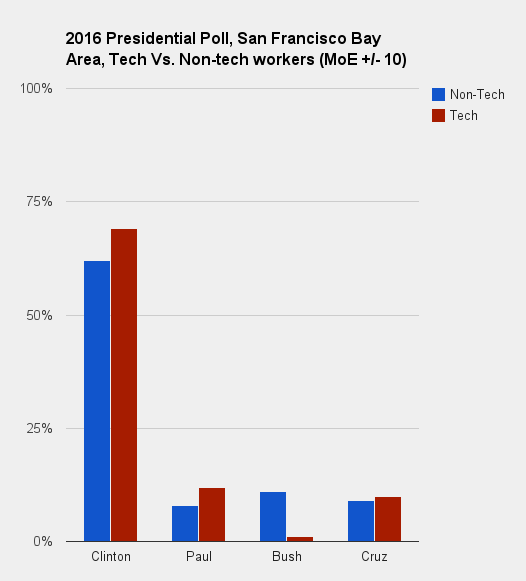
Ferenstein Wire-Google Surveys
Silicon Valley often gets stereotyped as a haven for libertarians, given the industry’s disdain for regulation and a culture that touts private sector innovation as a solution to society’s ills.
Yet, despite the stereotype, the San Francisco Bay Area is overwhelmingly liberal: 87 percent of donations from top Silicon Valley firms went to Obama in 2012 and so did 84 percent of the votes in the Bay Area.
In multiple interviews, libertarian hero and recent Republican presidential candidate, Rand Paul has told this writer that there is an untapped undercurrent of liberty-loving engineers ready to elect a small-government conservative.
So, I decided to conduct a poll of San Franciscans with the help of the fine folks at Google Surveys*. The survey finds that among all candidates — Hillary Clinton (D), Ted Cruz (R) , Rand Paul (R), Jeb Bush (R), Clinton was the overwhelming favorite. In fact, more San Franciscans would vote for her (65%) in 2016 then every other conservative contender combined.
Techies like Paul (Slightly) More Than Clinton, (a lot) more than Bush
Tech workers do have a libertarian streak. Twelve times more tech workers would vote for Paul (12 percent) than Jeb Bush (one percent). But, I must stress, the results are within the margin of error.
Either way, this isn’t entirely surprising: among those who identify with a political ideology, 12 percent of tech workers identify as libertarian.
What About Rich People?
Ok, maybe the middle-income engineers are liberal, but what about the wealthier San Francisco techies, who would face higher taxes under a Democratic administration?
Though it was in the margin of error, respondents who make more than $150,000 were four percent more likely (70 percent) to support Clinton, and almost half as likely to support Paul (four percent). This validates the sentiment among campaign insiders that America’s super-wealthy, such as Warrent Buffett and Bill Gates, tend to be Democrat loyalists.
*For Stat Nerds
The poll was conducted with Google Surveys, an online polling tool that reaches a representative sample of the United States. It has been used by many media outlets, including the New York Times.
The average margin of error is very high, because I’m reporting a sub-sample of the population. Anytime a pollster starts talking about the differences in gender, party, or race, expect that the normal margin of error could spike many multiples. The differences between Clinton and Paul are statistically significant; most other conclusions are borderline or not statistically significant (as is typical of a poll). I’ve chosen to be more explicit about the wide margin of error on subsamples.
Finally, workers self-identified their occupations.
Anyone is free to view and download the results from the survey here. For inquires about the R code I used, email at the details below. Or, if you’d like to re-analyze the data, feel free.
*The Ferenstein Wire is a syndicated wire service. Publishing partners may edit posts. For inquires, email the editor at greg at greg ferenstein dot com.

COMMENTS
Please let us know if you're having issues with commenting.